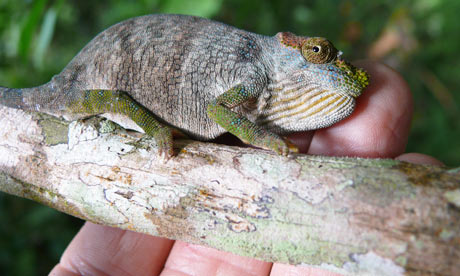TOP STORIES Killer Fungus Threatening Amphibians
Killer Fungus Threatening Amphibians
ScienceDaily - www.sciencedaily.com (Source: Society for General Microbiology)
23 Nov 2009
Photo credit: iStockphoto/Mark Kostich
Amphibians like frogs and toads have existed for 360 million years and survived when the dinosaurs didn't, but a new aquatic fungus is threatening to make many of them extinct, according to an article in the November issue of Microbiology Today.
The fungus, Batrachochytrium dendrobatidis (Bd),was found to be associated with waves of amphibian extinctions in Central America and north-eastern Australia in the 1990's. Bd infects over 350 amphibian species by penetrating their skin, but little else is known about where it came from and how it causes disease.
Cited Journal Article
>>>Disease-driven declines in global amphibian biodiversity. Microbiology Today. 2009 Nov. [Epub ahead of print].
 Our Earth Apes in Danger: Tourists Spread Disease
Our Earth Apes in Danger: Tourists Spread DiseaseBabelgum - www.babelgum.com
23 Nov 2009
Tourists walk through the forests in the Congo in the hope of a chance sighting of a wild chimpanzee, but do they realise the impact their colds and flus could have on the dwindling chimpanzee population? Interesting video from BBC wildlife show 'Apes In Danger'.
Disease may play role in quail decline
PressZoom.com - presszoom.com
23 Nov 2009
Disease may be playing a role in the demise of Texas quail, said a Texas AgriLife Extension Service expert.
“Quail season has been disappointing,” said Dr. Dale Rollins, AgriLife Extension wildlife specialist at San Angelo. “By Texas standards, wild quail hunting has been sub-par since 2006, and I’m wondering if disease might not be part of the puzzle. Certainly, it’s probably not the key reason, but I’m starting to suspect it may be a contributing factor.”
Rollins said coccidiosis ( malady caused by parasitic protozoans of the digestive system ) is often blamed, but exactly what disease might be behind the drop in quail populations, or even if there is a disease contributing to the problem, is currently unknown.
 Fight to protect California condors from lead ammunition moves to Arizona
Fight to protect California condors from lead ammunition moves to ArizonaScientific American - www.scientificamerican.com
20 Nov 2009
J Platt
. . . "Arizona has a pretty significant lead-poisoning problem," Miller says. "It's been worse than in California for the last few years, and the Arizona government is bending over backwards to hand out free nonlead ammo to hunters. Still, there have been quite a few lead-related deaths.
"It doesn't take many hunters using lead ammo to poison a significant number of birds," Miller says. "One flock of birds on a carcass can create an immediate crisis. We would have had more deaths if the condors were not so well managed and monitored."
 From Toxic Dust and Algae to Ill Winds From Africa
From Toxic Dust and Algae to Ill Winds From AfricaUSGS Newsroom - www.usgs.gov/newsroom
20 Nov 2009
- Eensy-weensy spiders play large role as sentinels of contaminants
- Invasive carp and the secret language of scent
- Toxic algae may be harming endangered suckers in Klamath Lake
- Wading through the sources of lake contamination
- Tiny particles with big effects
- Cause of feminized male sturgeon remains elusive
OTHER WILDLIFE HEALTH RELATED NEWS
Photo credit: Andrew Marshall/African Journal/PA
- Acid oceans leave fish at more risk from predators
- We're killing the oceans
- Feeding feathered gardeners in winter [Who benefits from winter feeding?]
- Wildlife Officials Warn About Chronic Wasting Disease [Maine]
- Shooting called answer to deer disease [Great Lakes]
 Snake spits out new species of chameleon at scientist's feet
Snake spits out new species of chameleon at scientist's feet- NEW SPECIES PICTURES: Deep-Sea "Jumbo Dumbo," More
WILDLIFE HEALTH RELATED PUBLICATIONS
Browse complete Digest publication library here.
Pathology of whooper swans (Cygnus cygnus) infected with H5N1 avian influenza virus in Akita, Japan, in 2008
J Vet Med Sci. 2009 Oct;71(10):1377-80.
S Ogawa et al.
Estimation of Wildlife Hazard Levels Using Interspecies Correlation Models and Standard Laboratory Rodent Toxicity Data
Journal of Toxicology and Environmental Health, Part A. 2009 Jan; 72(24): 1604 - 1609
JA Awkerman et al.
Molecular Characterization of a Novel Gammaretrovirus in Killer Whales (Orcinus orca)
J Virol. 2009 Dec;83(24):12956-12967. Epub 2009 Oct 7.
SA Lamere et al.
A 10-year wildlife survey of 15 species of Canadian carnivores identifies new hosts or geographic locations for Trichinella genotypes T2, T4, T5, and T6
Vet Parasitol. 2009 Oct 23. [Epub ahead of print]
AA Gajadhar and LB Forbes
Local Scale Effects of Disease on Biodiversity
Ecohealth. 2009 Nov 18. [Epub ahead of print]
KF Smith et al.
Ocean acidification disrupts the innate ability of fish to detect predator olfactory cues
Ecol Lett. 2009 Nov 16. [Epub ahead of print] [letter]
Dixson DL, Munday PL, Jones GP.




